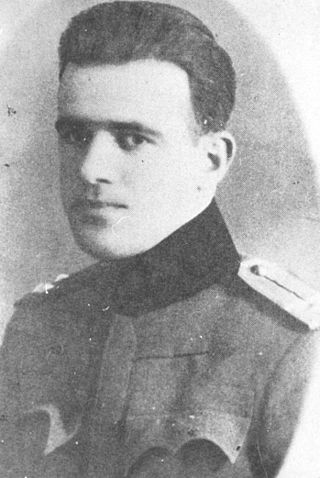
The Battle of Loznica involved an attack on the German garrison of that town by the Jadar Chetnik Detachment on 31 August 1941. Following the World War II German-led Axis invasion of Yugoslavia in April 1941, the Kingdom of Yugoslavia was partitioned. At the time, Loznica was part of the German-occupied territory of Serbia, which included Serbia proper, with the addition of the northern part of Kosovo, and the Banat.
Milivoje Trbić, known as Vojče (Војче) or Voja (Воја), was a Yugoslav army captain (kapetan) and member of the Chetniks during World War II in Yugoslavia.

Gligor Sokolović was one of the supreme commanders of the Serbian Chetnik Movement, that fought the Ottoman Empire, Bulgarian, and Albanian armed bands during the Macedonian Struggle. He was one of the most famous Chetniks, and the foremost in Western Povardarie. In Bulgaria he is considered a Bulgarian renegade who switched sides, i.e. (sic) Serboman.
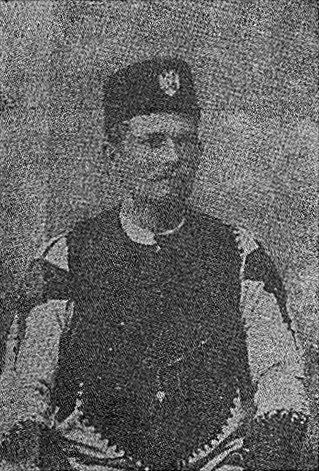
Vasilije Trbić was a Serbian Chetnik commander in Macedonia who became a politician in the Kingdom of Serbs, Croats and Slovenes, first representing the People's Radical Party (NRS) in the country's National Assembly and later the Yugoslav National Party (JNP). Born in the village of Bijelo Brdo, near Dalj in Austria-Hungary, Trbić was a monk in his youth. He fled Mount Athos after being accused of murdering several fellow monks and joined the nationalist band of Jovan Drimkolski in 1904–05, quickly becoming the unit's commander. Trbić fought alongside Serbian forces during the Balkan Wars and during World War I, earning the Order of the Star of Karađorđe for his efforts. Acting alongside other former Chetnik commanders, he participated in establishing organizations whose purpose was to raise monuments to Serbian military successes from 1912–18 and to promote cultural development in Macedonia in the interwar period. He died in 1962.

Doksim Mihailović was a Macedonian Serb voivode, originally a teacher, who joined the Serbian Chetnik Organization to fight in Ottoman Macedonia, and then the Balkan Wars. Originally a teacher, he fought against the Ottomans army and later Bulgarian guerrilla bands in the Kosovo Vilayet.

The Serbian Revolutionary Organization or Serbian Chetnik Organization was a paramilitary revolutionary organization with the aim of liberation of Old Serbia from the Ottoman Empire. Its Central Committee was established in 1902, while the Serbian Committee was established in September 1903 in Belgrade, by the combined Central Boards of Belgrade, Vranje, Skopje and Bitola. Its armed wing was activated in 1904. Among the architects were members of the Saint Sava society, Army Staff and Ministry of Foreign Affairs. It operated during the Struggle for Macedonia, a series of social, political, cultural and military conflicts in the region of Macedonia; its operations are known as Serb Action in Macedonia.
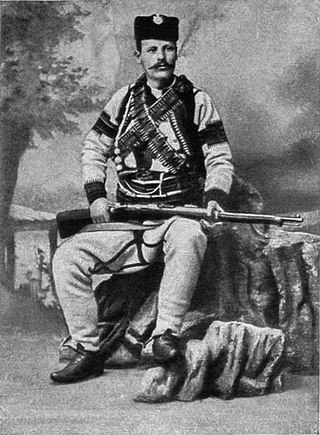
Jovan Stojković, known as Jovan Babunski, was a Serbian Chetnik commander during the Macedonian Struggle, Balkan Wars and World War I. Following the murder of his brother and nephew by the Internal Macedonian Revolutionary Organization (IMRO), he joined a Chetnik band and took command of Chetnik units on the Vardar River, where he and his men often engaged Bulgarian and Ottoman forces.
Tasa Konević Apostolović was an Orthodox priest and Macedonian Serb Chetnik from Krapa in Poreče. He was the son of a local Serb chief, Kone Apostolović, who was the leader of the Prilep Serbs at the end of the 19th century, and one of the richest in the village. Priest Tasa was the protector of Serbdom in Poreče and led the local guerrilla organization. He participated in the Ilinden Uprising, orchestrated by the Bulgarian-organized Internal Macedonian Revolutionary Organization (IMRO), with a Serb band. After the Kokošinje slaughters and IMRO and exarchists attack on Macedonian Serbs, he organized the village self-defense units and joined Gligor Sokolović and his neighbour Trenko Rujanović, of the Serbian Chetnik Organization. Tasa defended and administrated the village throughout the Macedonian Struggle. An important event was the attack on Krapa by combined bands of the IMRO, which ended in the Battle of Šuplji Kamen won by the Serbian Chetniks. Tasa was murdered in 1916, in the Kokošinje murders when the occupying Bulgarian Army executed 104 Serb leaders from Poreče.

Rade Radivojević, known as Vojvoda Dušan (Душан), was a Serbian Chetnik vojvoda in Old Serbia and Macedonia during the Macedonian Struggle.

Todor Krstić, known by the nickname Toša (Тоша) and nom de guerreAlgunjski (Алгуњски), was a Serbian Chetnik commander in Old Serbia and Macedonia during the Macedonian Struggle. In Bulgaria he is considered a Bulgarian renegade who switched sides, i.e. (sic) Serboman.
The Battle of Čelopek was fought at the Čelopek plateau, near Kozjak, between the Serbian Chetnik Organization and Ottoman officers accompanied by Ottoman Albanian bashi-bozuks, on 16 April 1905.

Jovan Cvetković, known as Jovan Dolgač, was a Serbian Chetnik commander in Macedonia, who also participated in the Balkan Wars and World War I in the Chetnik detachments of the Serbian Army. In Bulgaria he is considered a Bulgarian renegade who switched sides, i.e. (sic) Serboman.
The Battle of Velika Hoča between the Serbian Chetnik Organization, a Serbian rebel faction, and Ottoman irregulars from Orahovac, Kosovo, took place on 25 May 1905.

Petko Ilić was a Serbian Chetnik commander active in Macedonia.

Jovan Stanojković, known by his nom de guerre, the demonym Dovezenski (Довезенски), was a Serbian Chetnik commander (vojvoda), and participant in the Balkan Wars, in the Battle of Kumanovo, and World War I. He was originally a teacher who turned into a guerilla fighter following Bulgarian oppression on Serb people in Macedonia. He rose in ranks and became one of the supreme commanders in Macedonia.
The Battle of Šuplji Kamen between the Serbian Chetnik Organization and the Ottoman army under Hamdi Pasha, took place on 27 May 1904.
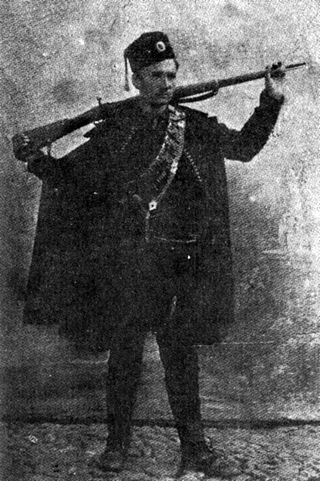
Dragiša M. Stojadinović, known by his nom de guerreKrajinac (Крајинац), was a Serbian soldier, lawyer, politician, photographer and filmmaker.

Đorđe Cvetković, known by the nom de guerreDrimkolski (Дримколски), was a Serbian Chetnik vojvoda (commander) of the četa (band) of Drimkol.
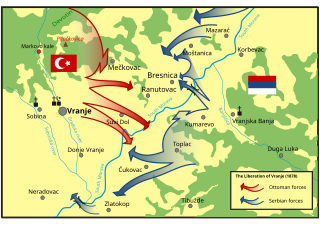
The Battle of Vranje, or the Liberation of Vranje, represented one of the final stages of the second phase of the Serbian–Ottoman War (1876–78). At the beginning of the war, the Serbian army began the offensive in what is today South Serbia. After the Battle of Grdelica, the Serbian army managed to break into the Masurica Valley leaving the road to Vranje open and unguarded. At the same time, many rebellions broke out in the Serbian-Ottoman border areas, including in the Vranje region, against Ottoman authority. To help the rebels, the Serbian command decided to send Lieutenant Stepa Stepanović to form a special rebel battalion.
The Battle of Vladilovci occurred between Serbian Chetniks, Bulgarian committees (IMRO) and Ottoman forces on 9 March 1907, as part of the Macedonian Struggle.














